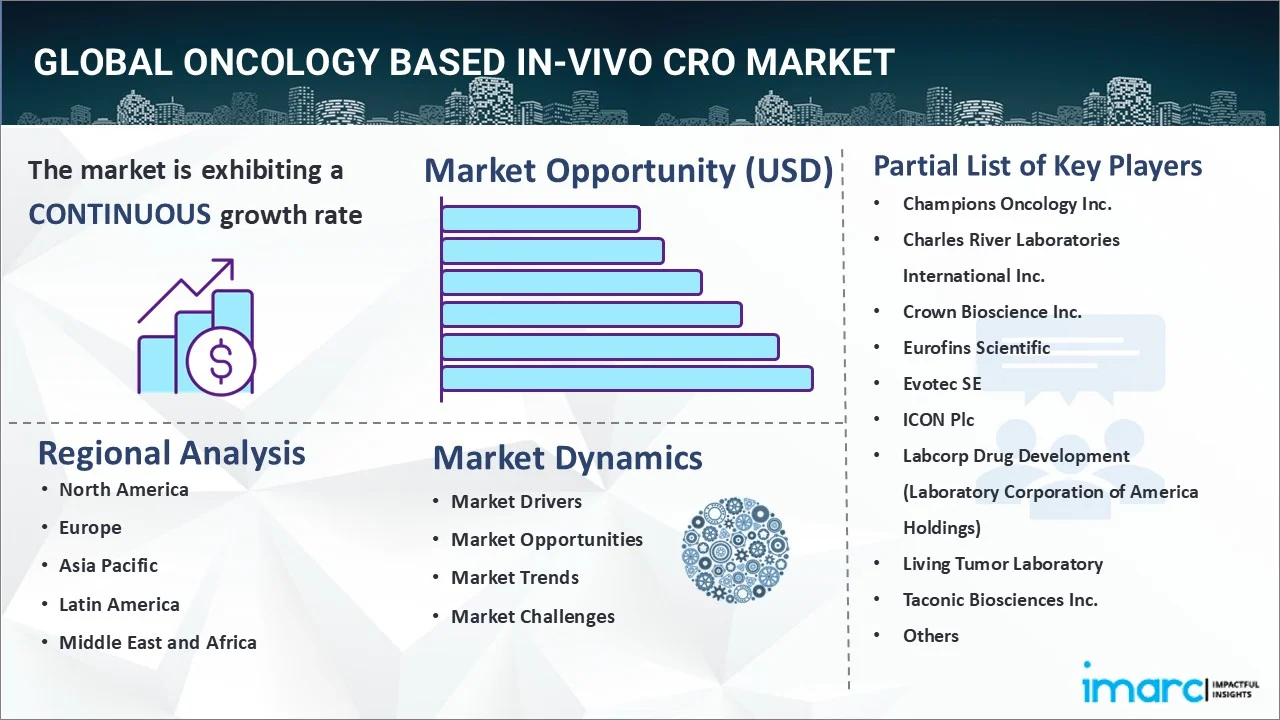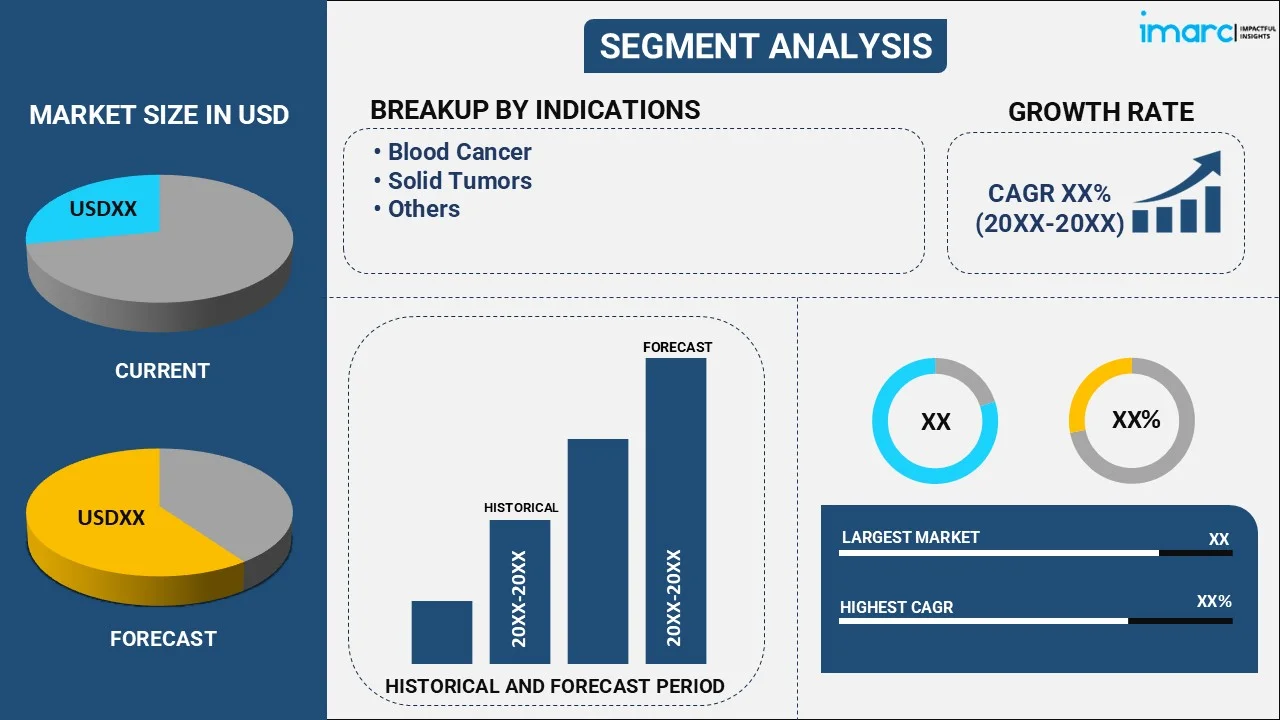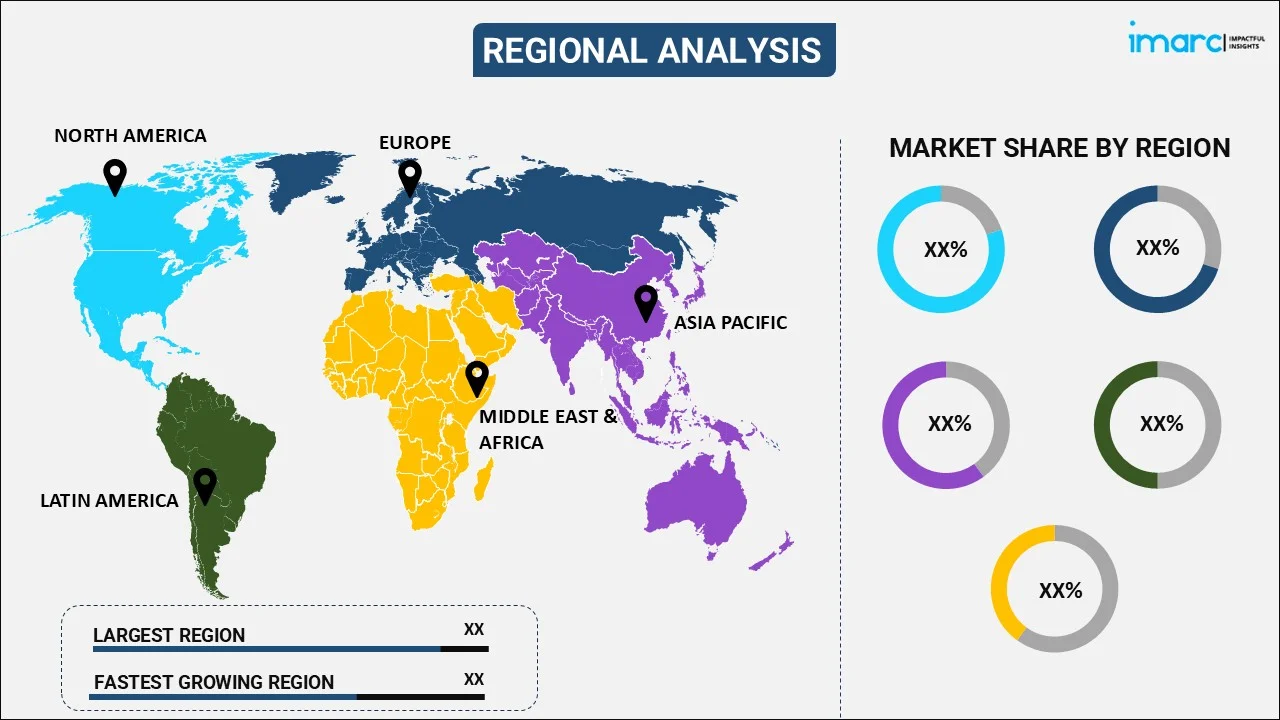
Oncology Based In-Vivo CRO Market Report by Indication (Blood Cancer, Solid Tumors, and Others), Model (Syngeneic, Xenograft, Patient Derived Xenograft (PDX), and Others), Application (Hospitals, Rehabilitation Centers), and Region 2025-2033
Global Oncology Based In-Vivo CRO Market:
The global oncology based in-vivo CRO market size reached USD 1.3 Billion in 2024. Looking forward, IMARC Group expects the market to reach USD 2.4 Billion by 2033, exhibiting a growth rate (CAGR) of 6.55% during 2025-2033. The rising prevalence of cancer, regulatory compliances, ongoing technological advancements, and the surging demand for personalized medicines are driving the market growth.
|
Report Attribute
|
Key Statistics
|
|---|---|
|
Base Year
|
2024
|
|
Forecast Years
|
2025-2033
|
|
Historical Years
|
2019-2024
|
|
Market Size in 2024
|
USD 1.3 Billion |
|
Market Forecast in 2033
|
USD 2.4 Billion |
| Market Growth Rate 2025-2033 | 6.55% |
Oncology Based In-Vivo CRO Market Analysis:
- Major Market Drivers: The growing prevalence of cancer around the world represents one of the key factors driving the market. Moreover, governments of several countries across the globe are extensively investing in research and development (R&D) activities, which is driving industry’s growth.
- Key Market Trends: The wide availability of personalized treatment techniques, along with the expanding healthcare industry, is catalyzing the demand for oncology based in-vivo CRO worldwide. Additionally, there is an increase in the adoption of telehealth and virtual clinical trials in the healthcare industry to ensure the safety of cancer patients. This is projected to bolster the growth of the market.
- Competitive Landscape: Some of the prominent oncology based in-vivo CRO market companies in the market include Champions Oncology Inc., Charles River Laboratories International Inc., Crown Bioscience Inc., Eurofins Scientific, Evotec SE, ICON Plc, Labcorp Drug Development (Laboratory Corporation of America Holdings), Living Tumor Laboratory, Taconic Biosciences Inc., The Jackson Laboratory, WuXi AppTec, and Xentech, among many others.
- Geographical Trends: According to the oncology based in-vivo CRO market dynamics, North America exhibits a clear dominance in the market. The prevalence of various types of cancer continues to increase in the region, driving oncology based in-vivo CRO market demand.
- Challenges and Opportunities: Regulatory and compliance burden, and the increasing demand for customized clinical trial protocols are hampering the market growth. However, AI-driven algorithms for data analytics, predictive modeling, and patient stratification enhance efficiency and decision-making in oncology research.

Oncology Based In-Vivo CRO Market Trends:
Rising Prevalence of Cancer
The rising prevalence of cancer is a significant driver behind the growth of the oncology-based in-vivo Contract Research Organization (CRO) market. Cancer continues to be a major public health challenge worldwide, with increasing incidence rates across various types of cancers. For instance, the IARC's 2022 study showed around 20 million new cancer cases and nearly nine million deaths worldwide, with lung and breast cancer being the most common. Similarly, according to an article published by the Union for International Cancer Control, cancer cases are projected to rise to 35 million by 2050. The complexity of cancer requires tailored treatment approaches, leading to a higher demand for clinical trials and research services provided by CROs. These factors are positively influencing the oncology based in-vivo CRO market revenue.
Increasing Emphasis on Personalized Medicine
The increasing emphasis on personalized medicine is a major driver behind the growth and evolution of the oncology-based in-vivo Contract Research Organization (CRO) market. For instance, according to Statista, personalized medical care, medicines, and diagnostics were estimated to account for around 40% of total revenue in 2022. Oncology is the most significant therapeutic area for personalized medicine. Tailoring treatments to individual patients improves efficacy, reduces adverse effects, and enhances overall treatment outcomes, driving the demand for CROs with expertise in personalized medicine, thereby positively influencing the oncology based in-vivo CRO industry forecast.
Technological Advancements
Increasing technological advancements are escalating the demand for oncology-based in-vivo Contract Research Organizations. Improved imaging modalities, such as PET-CT, MRI, and molecular imaging techniques have enabled better visualization and monitoring of tumors in vivo. For instance, in June 2024, Siemens Healthineers launched the Biograph Trinion, their latest PET/CT scanner, at the annual meeting of the Society of Nuclear Medicine and Molecular Imaging. The scanner's detector is based on lutetium oxyorthosilicate (LSO) crystal elements and delivers high spatial resolution and an ultrafast time-of-flight performance of 239 picoseconds for small lesion detectability and effective sensitivity up to 128 cps/kBq, allowing for fast scans and low patient radiation doses. This enhances the ability to track disease progression and response to treatments more accurately. These factors are further bolstering the oncology-based in-vivo CRO market revenue.
Global Oncology Based In-Vivo CRO Industry Segmentation:
IMARC Group provides an analysis of the key trends in each segment of the global oncology based in-vivo CRO market report, along with forecasts at the global, regional and country levels from 2025-2033. Our report has categorized the market based on indication, model and application.
Breakup by Indication:

- Blood Cancer
- Solid Tumors
- Others
Solid tumors currently represent the largest market share
The report has provided a detailed breakup and analysis of the market based on the indication. This includes blood cancer, solid tumors, and others. According to the report, solid tumors represented the largest market segmentation.
According to the oncology-based in-vivo CRO market outlook, solid tumors are the most common type of cancer, encompassing a wide range of malignancies such as breast, lung, colorectal, and prostate cancers. Their prevalence ensures a large patient population for clinical trials, making them attractive for CROs and pharmaceutical companies. Moreover, there has been a significant increase in the number of cancer patients. For instance, the American Cancer Society, the major source of cancer statistics and data, estimated nearly 1,685,210 new cancer cases and 595,690 deaths in the United States in 2021.
Breakup by Model:
- Syngeneic
- Xenograft
- Patient Derived Xenograft (PDX)
- Others
Currently, Patient Derived Xenograft (PDX) model accounts for the majority of the total market share
The report has provided a detailed breakup and analysis of the market based on the model. This includes syngeneic, xenograft, patient derived xenograft (PDX), and others. According to the report, the Patient Derived Xenograft (PDX) model accounts for the majority of the total market share.
According to the oncology-based in-vivo CRO market overview, PDX models involve implanting patient-derived tumor tissue into immunodeficient mice, thereby preserving the molecular and histological characteristics of the original tumor. This model closely mimics human tumor biology and heterogeneity, making it invaluable for studying cancer progression, metastasis, and treatment response. Moreover, these models are highly predictive of patient response to therapies, including chemotherapy, targeted therapy, and immunotherapy. Pharmaceutical companies and biotech firms rely on PDX studies to assess drug efficacy, optimize treatment regimens, and identify potential biomarkers for patient stratification.
Breakup by Application:
- Hospitals
- Rehabilitation Centers
The oncology-based in-vivo CRO market report has provided a detailed breakup and analysis of the market based on the application. This includes hospitals and rehabilitation centers.
Hospitals frequently collaborate with CROs to conduct clinical trials for evaluating new oncology treatments. CROs provide expertise in study design, protocol development, patient recruitment, and regulatory compliance, enabling hospitals to participate in cutting-edge research without diverting resources from patient care. While rehabilitation centers may participate in clinical trials focused on cancer survivors who require rehabilitation services to improve their quality of life post-treatment. CROs can support such trials by providing expertise in study design, outcome measures, and data management specific to this patient population.
Breakup by Region:

- North America
- United States
- Canada
- Asia-Pacific
- China
- Japan
- India
- South Korea
- Australia
- Indonesia
- Others
- Europe
- Germany
- France
- United Kingdom
- Italy
- Spain
- Russia
- Others
- Latin America
- Brazil
- Mexico
- Others
- Middle East and Africa
North America currently dominates the global market
The report has also provided a comprehensive analysis of all the major regional markets, which include North America (the United States and Canada); Europe (Germany, France, the United Kingdom, Italy, Spain, Russia and others); Asia Pacific (China, Japan, India, South Korea, Australia, Indonesia, and others); Latin America (Brazil, Mexico, and others); and the Middle East and Africa. According to the report, North America accounted for the largest market share.
According to the oncology based in-vivo CRO market statistics, the rising incidence of cancer cases in North America continues to drive demand for innovative therapies and treatment options. For instance, the Globocan 2021 report estimated that nearly 2,281,000 new cancer cases were diagnosed in the United States in 2021, with almost 612,000 fatalities. Oncology-focused CROs play a critical role in advancing research and development efforts to address unmet medical needs across various cancer types. Moreover, continuous advancements in technology, including molecular profiling, genomic sequencing, imaging modalities (such as PET-CT and MRI), and high-throughput screening platforms, enhance the capabilities of CROs to conduct sophisticated in-vivo studies. These technologies enable precise characterization of tumors, identification of biomarkers, and evaluation of therapeutic efficacy, contributing to the growth of oncology based CRO services.
Competitive Landscape:
The market research report has provided a comprehensive analysis of the competitive landscape. Detailed profiles of all major market companies have also been provided. Some of the key players in the market include:
- Champions Oncology Inc.
- Charles River Laboratories International Inc.
- Crown Bioscience Inc.
- Eurofins Scientific
- Evotec SE
- ICON Plc
- Labcorp Drug Development (Laboratory Corporation of America Holdings)
- Living Tumor Laboratory
- Taconic Biosciences Inc.
- The Jackson Laboratory
- WuXi AppTec
- Xentech
(Please note that this is only a partial list of the key players, and the complete list is provided in the report.)
Oncology Based In-Vivo CRO Market Recent Developments:
- June 2024: Siemens Healthineers launched the Biograph Trinion, their latest PET/CT scanner, at the annual meeting of the Society of Nuclear Medicine and Molecular Imaging.
- May 2024: The NHS launched a clinical trial in which patients would receive customized cancer vaccinations created by BioNTech and Genentech. The vaccine under study used mRNA technology and was personalized to the individual's cancer mutations.
- March 2024: Veeda Clinical Research Limited, a contract research organization (CRO) with a track record of successful drug development, acquired Heads, a privately held European CRO that conducts oncology clinical trials.
Oncology Based In-Vivo CRO Market Report Scope:
| Report Features | Details |
|---|---|
| Base Year of the Analysis | 2024 |
| Historical Period | 2019-2024 |
| Forecast Period | 2025-2033 |
| Units | Billion USD |
| Scope of the Report | Exploration of Historical Trends and Market Outlook, Industry Catalysts and Challenges, Segment-Wise Historical and Predictive Market Assessment:
|
| Indications Covered | Blood Cancer, Solid Tumors, Others |
| Models Covered | Syngeneic, Xenograft, Patient Derived Xenograft (PDX), Others |
| Applications Covered | Hospitals, Rehabilitation Centers |
| Regions Covered | Asia Pacific, Europe, North America, Latin America, Middle East and Africa |
| Countries Covered | United States, Canada, Germany, France, United Kingdom, Italy, Spain, Russia, China, Japan, India, South Korea, Australia, Indonesia, Brazil, Mexico |
| Companies Covered | Champions Oncology Inc., Charles River Laboratories International Inc., Crown Bioscience Inc., Eurofins Scientific, Evotec SE, ICON Plc, Labcorp Drug Development (Laboratory Corporation of America Holdings), Living Tumor Laboratory, Taconic Biosciences Inc., The Jackson Laboratory, WuXi AppTec, Xentech, etc. |
| Customization Scope | 10% Free Customization |
| Post-Sale Analyst Support | 10-12 Weeks |
| Delivery Format | PDF and Excel through Email (We can also provide the editable version of the report in PPT/Word format on special request) |
Key Benefits for Stakeholders:
- IMARC's report offers a comprehensive quantitative analysis of various market segments, historical and current market trends, market forecasts, and dynamics of the oncology based in-vivo CRO market from 2019-2033.
- The research study provides the latest information on the market drivers, challenges, and opportunities in the global oncology based in-vivo CRO market.
- The study maps the leading, as well as the fastest-growing, regional markets. It further enables stakeholders to identify the key country-level markets within each region.
- Porter's five forces analysis assists stakeholders in assessing the impact of new entrants, competitive rivalry, supplier power, buyer power, and the threat of substitution. It helps stakeholders to analyze the level of competition within the oncology based in-vivo CRO industry and its attractiveness.
- The competitive landscape allows stakeholders to understand their competitive environment and provides insight into the current positions of key players in the market.
Key Questions Answered in This Report
The global oncology based in-vivo CRO market was valued at USD 1.3 Billion in 2024.
We expect the global oncology based in-vivo CRO market to exhibit a CAGR of 6.55% during 2025-2033.
The high prevalence of cancer, along with the growing utilization of oncology-based in-vivo CRO for offering hormonal therapy, immunotherapy, radiotherapy, and oral therapies to patients for easing the side effects of cancer, is primarily driving the global oncology based in-vivo CRO market.
The sudden outbreak of the COVID-19 pandemic had led to postponement of various therapies for cancer treatments to reduce the risk of coronavirus infection upon hospital visits, thereby limiting the demand for oncology-based in-vivo CRO procedures.
Based on the indication, the global oncology based in-vivo CRO market has been segmented into blood cancer, solid tumors, and others. Among these, solid tumors currently represent the largest market share.
Based on the model, the global oncology based in-vivo CRO market can be bifurcated into syngeneic, xenograft, Patient Derived Xenograft (PDX), and others. Currently, Patient Derived Xenograft (PDX) model accounts for the majority of the total market share.
On a regional level, the market has been classified into North America, Europe, Asia-Pacific, Middle East and Africa, and Latin America, where North America currently dominates the global market.
Some of the major players in the global oncology based in-vivo CRO market include Champions Oncology Inc., Charles River Laboratories International Inc., Crown Bioscience Inc., Eurofins Scientific, Evotec SE, ICON Plc, Labcorp Drug Development (Laboratory Corporation of America Holdings), Living Tumor Laboratory, Taconic Biosciences Inc., The Jackson Laboratory, WuXi AppTec, and Xentech.
Need more help?
- Speak to our experienced analysts for insights on the current market scenarios.
- Include additional segments and countries to customize the report as per your requirement.
- Gain an unparalleled competitive advantage in your domain by understanding how to utilize the report and positively impacting your operations and revenue.
- For further assistance, please connect with our analysts.
 Inquire Before Buying
Inquire Before Buying
 Speak to an Analyst
Speak to an Analyst
 Request Brochure
Request Brochure
 Request Customization
Request Customization




.webp)




.webp)












